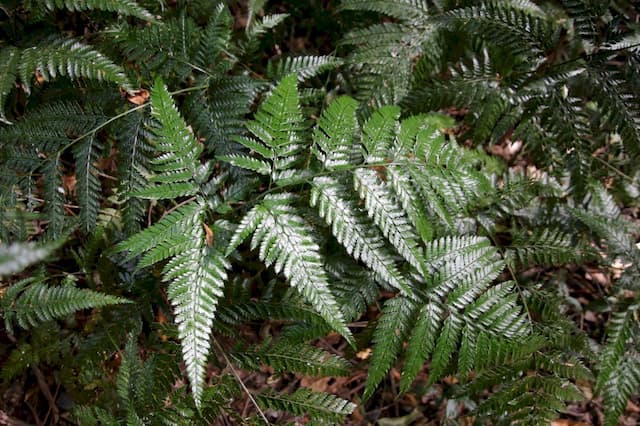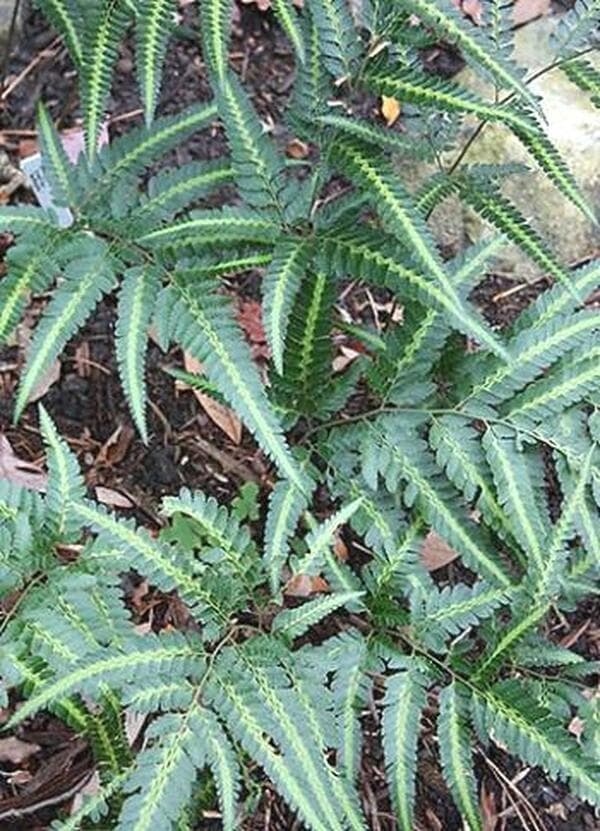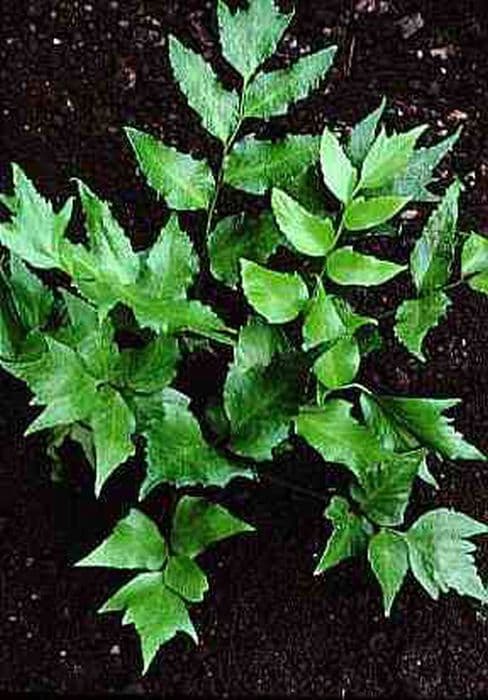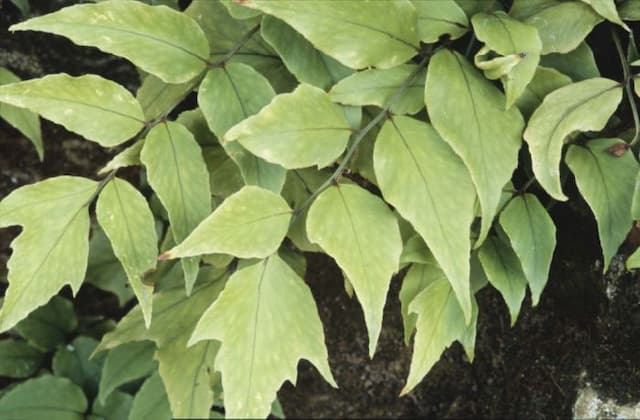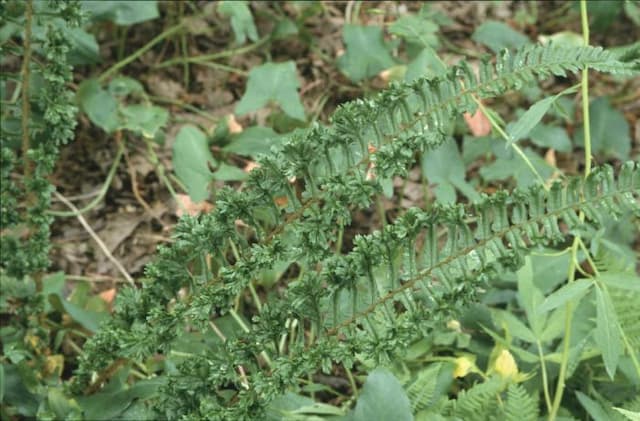Braun's Holly Fern Polystichum braunii

ABOUT
The plant commonly known as Braun's holly fern is a perennial fern with a lush and attractive appearance. Its fronds are dark green and glossy, giving the fern a vibrant and healthy look. The fronds are arching and divided, creating a textured visual interest. Each frond typically has numerous small leaflets that are neatly arranged on either side of a central stem. The leaflets' edges may be slightly toothed, further adding to the intricate detail of the plant's overall aesthetic. The foliage of Braun's holly fern is evergreen in suitable climates, meaning it maintains its color and presence throughout the year, offering continual visual appeal. The plant exhibits a balanced and symmetrical growth habit, typically forming a neat, rounded shape that contributes to its ornamental value in garden settings. It's often appreciated for the elegant and somewhat formal appearance it can provide in shady garden areas, under trees, or as a feature in nature-themed landscaping designs.
About this plant
 Names
NamesFamily
Dryopteridaceae
Synonyms
Braun's Holly Fern, Northern Hollyfern
Common names
Aspidium braunii, Polystichum aculeatum var. braunii, Polystichum lobatum, Aspidium lobatum, Polystichum braunii var. purshii, Polystichum purshii
 Toxicity
ToxicityTo humans
Polystichum braunii, commonly known as Braun's Holly Fern, is not considered toxic to humans. There are no well-documented cases or significant concerns regarding poisoning from ingesting any part of this plant. Therefore, consumption of Braun's Holly Fern typically does not result in harmful symptoms or consequences for humans.
To pets
Braun's Holly Fern is also not considered toxic to pets. There is no indication that ingestion of any part of the Polystichum braunii plant poses a risk for pets such as dogs and cats. Hence, there should be no symptoms of poisoning or adverse consequences if pets consume this fern. However, it is generally advisable to prevent pets from eating plants as a precautionary measure.
 Characteristics
CharacteristicsLife cycle
Perennials
Foliage type
Evergreen
Color of leaves
Green
Height
2 feet (0.61 meters)
Spread
2 feet (0.61 meters)
Plant type
Fern
Hardiness zones
5
Native area
Europe
Benefits
 General Benefits
General Benefits- Ornamental value: Polystichum braunii, also known as Braun's Holly Fern, is valued for its aesthetic appeal with attractive, glossy green foliage that can enhance landscaped areas, gardens, or indoor spaces.
- Shade tolerance: Braun's Holly Fern can thrive in low-light conditions, making it ideal for shaded gardens or indoor areas with limited natural light.
- Soil erosion control: Its dense root system can help stabilize soil and control erosion, particularly in shady, sloped, or woodland settings.
- Wildlife support: The fern can provide habitat and shelter for small wildlife, such as birds and insects, contributing to local biodiversity.
- Drought resistance: Once established, Braun's Holly Fern is relatively drought-resistant, requiring minimal watering and making it a low-maintenance option for gardeners.
- Winter interest: With its evergreen foliage, Braun's Holly Fern provides visual interest in the garden throughout the winter months when many plants are dormant or have died back.
- Low maintenance: It requires minimal upkeep, with no need for regular pruning or deadheading, making it a convenient choice for busy or novice gardeners.
- Non-invasive: Unlike some fern species, Braun's Holly Fern is not known to be invasive and tends to grow within manageable bounds.
 Medical Properties
Medical PropertiesThis plant is not used for medical purposes.
 Air-purifying Qualities
Air-purifying QualitiesThis plant is not specifically known for air purifying qualities.
 Other Uses
Other Uses- Companion planting: Polystichum braunii, commonly known as Braun's Holly Fern, can be used in gardens as companion plants to provide a lush, contrasting backdrop for flowering plants or to create textural diversity.
- Floral arrangements: The fronds of Braun's Holly Fern are often used in floral arrangements to add greenery and structure due to their durability and attractive appearance.
- Erosion control: The fern can be planted on slopes or in areas prone to erosion to help stabilize the soil with its root system.
- Shade gardens: Due to its preference for shade, Braun's Holly Fern is ideal for adding greenery to darker areas of the garden where other plants might not thrive.
- Diorama projects: The fronds of Braun's Holly Fern can be incorporated into dioramas or miniature gardens for a realistic woodland effect.
- Habitat creation: The plant can be used to create habitats for small wildlife, offering shelter and a microclimate that benefits various insects and small animals.
- Education: Braun's Holly Fern can be used in educational settings, such as schools or botanical gardens, to teach about fern reproduction and lifecycle.
- Culinary decoration: While not edible, the fronds can be used as a decorative, natural accent on serving plates for culinary presentations.
- Photography: Braun's Holly Fern provides an excellent, picturesque element for nature photographers seeking to capture the essence of a fern-rich environment.
- Theatrical use: The fronds can be integrated into stage designs and set decorations for plays or other performances to evoke a natural woodland scene.
Interesting Facts
 Feng Shui
Feng ShuiThe Polystichum braunii, commonly known as Braun's Holly Fern, is not used in Feng Shui practice.
 Zodiac Sign Compitability
Zodiac Sign CompitabilityBraun's Holly Fern is not used in astrology practice.
 Plant Symbolism
Plant Symbolism- Resilience: Polystichum braunii, commonly known as Braun's Holly Fern, is an evergreen plant that maintains its lush appearance even in adverse conditions, symbolizing the ability to withstand challenges and persevere.
- Protection: The Holly Fern's dense fronds have a protective quality, making the plant emblematic of shelter and safety.
- Timelessness: As a plant that keeps its foliage throughout the year, the Braun's Holly Fern represents enduring qualities and everlasting values.
- Tranquility: With its deep green fronds that evoke a sense of calm and natural beauty, this fern is often associated with inner peace and the soothing of souls.
 Water
WaterFor the Braun's Holly Fern, maintain even moisture by watering it with approximately 16 ounces of water once a week during active growth periods in spring and summer. The goal is to keep the soil lightly moist but not soggy. In the dormant months of fall and winter, reduce watering to every other week, ensuring the soil slightly dries out between watering sessions. Avoid overhead watering to prevent water on the foliage, which could lead to fungal issues. Always check the top inch of soil for dryness before watering to prevent overwatering.
 Light
LightBraun's Holly Fern thrives in partial to full shade conditions. It should be placed in a location that receives dappled sunlight or indirect light, as direct sunlight can scorch the leaves. A spot under a tree canopy or on a shaded patio is ideal for this fern to prevent exposure to the harsh afternoon sun.
 Temperature
TemperatureBraun's Holly Fern prefers a temperature range between 60°F and 75°F for optimum growth. It can tolerate a minimum temperature of 50°F but should be protected from temperatures below this range. The ideal conditions for this plant exclude exposure to sudden temperature changes and drafts.
 Pruning
PruningPruning Braun's Holly Fern involves removing any dead or damaged fronds to maintain a tidy appearance and promote healthy growth. This can be done as needed throughout the year but is best performed in the spring to make room for new growth. There is no need for regular pruning beyond this maintenance.
 Cleaning
CleaningAs needed
 Soil
SoilBraun's Holly Fern thrives in a soil mix consisting of equal parts peat, pine bark, and perlite, promoting good drainage and aeration. The ideal soil pH for this fern should be slightly acidic to neutral, ranging from 6.0 to 7.2.
 Repotting
RepottingBraun's Holly Fern should be repotted every 2 to 3 years to refresh the soil and accommodate root growth. It is best to repot in spring before the growing season starts.
 Humidity & Misting
Humidity & MistingBraun's Holly Fern prefers high humidity levels, ideally between 60% to 80%. It thrives in moist, well-ventilated environments free of cold drafts or dry air.
 Suitable locations
Suitable locationsIndoor
Keep Braun's Holly Fern in indirect light, ensure high humidity.
Outdoor
Plant in shade, protect from wind, ensure soil is moist.
Hardiness zone
5-8 USDA
 Life cycle
Life cyclePolystichum braunii, commonly known as Braun's Holly Fern, begins its life cycle with the germination of spores, which are produced in sporangia located on the undersides of mature fronds. The spores develop into a small, heart-shaped gametophyte, which is the sexual phase of the plant, containing both male and female reproductive structures. After fertilization, the gametophyte gives rise to a new sporophyte, which is the fern plant that we recognize, starting as a tiny fiddlehead. These fiddleheads unfurl into fronds, a process called circinate vernation, as the fern grows and matures. Mature Braun's Holly Ferns will eventually produce sporangia of their own, continuing the life cycle. The plant is perennial and will go through this growth cycle annually, with fronds typically dying back in winter and regrowing each spring.
 Propogation
PropogationPropogation time
Spring-early summer
The most popular method for propagating Polystichum braunii, commonly known as Braun's Holly Fern, is through spore collection and germination. Best done in late summer when the spores are ripe, the process begins by harvesting the spore-laden fronds. These fronds are then placed in a paper bag to dry, allowing the spores to fall out naturally. Once collected, the spores are sown on the surface of a sterilized peat-based mix or fine-grade vermiculite and kept in indirect light at a constant temperature, which is ideally between 68-72 degrees Fahrenheit (20-22 degrees Celsius). The surface must be kept moist, which is often achieved by covering the container with a clear lid or plastic wrap, creating a miniature greenhouse effect. Germination can occur in a few weeks to several months, and once the spores have developed into prothalli, they will eventually form young ferns that can be transplanted into individual pots.
